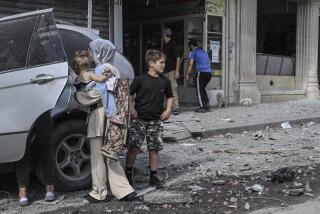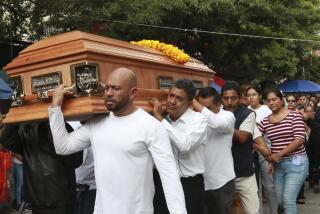Sandinistas Must Go, Many Feel : Contra Troops Uneasy Over Cease-Fire, Talks
- Share via
LA VIGIA, Nicaragua — Six years ago, before the war engulfed him, he was a teen-age farm boy struggling to help his family manage under the new rules of revolutionary Nicaragua.
“I drove a truck for my father, but when they started rationing everything, we couldn’t get gasoline,” he remembers now. “I had to stand in line with a ration card for a pound of sugar. It was humiliating.”
As word spread through northern Nicaragua that the Sandinista government was trying to implant communism, armed resistance grew. In Planes de Vilan, the hamlet where the boy lived, a friend was picked up by the security police, questioned about the insurgency and later found dead.
‘With All My Heart’
“When the Sandinistas came recruiting by force, I had to choose one army or the other,” the former farm boy recalled. The next time a rebel patrol passed through, “I joined it, with all my heart, all my will.”
Since then, he has adopted a nom de guerre, Maitre, and has never looked back. Today, as Nicaragua faces the prospect of peace, this dark, thin 24-year-old says he feels trapped in a conflict by the same grievances that made him a Contra at age 18.
In interviews this week, Maitre and other veteran rebel foot soldiers, who are observing a two-month cease-fire, said they will never put down their weapons until the Sandinista misdeeds that drove them to war are eliminated. To most of them, this is inconceivable unless the Sandinistas themselves are gone from power.
“I will put down this rifle when Nicaragua is free,” Maitre said, cradling an AK-47. “It is a lie to say the Sandinistas can make Nicaragua free. There would have to be a new government elected by the people. If not, we will keep fighting.”
The hard line voiced by rebel soldiers is a sign of the difficulties faced by the preliminary peace accord signed March 23 in Sapoa, Nicaragua.
The Nicaraguan Resistance leaders, who were to have arrived Friday in Managua to try to negotiate a lasting political settlement of the six-year war, speak for a guerrilla army that, despite the cutoff of U.S. military aid, seems disciplined, well indoctrinated and convinced of its ability to survive.
Publicly, Sandinista negotiators portray the rebel soldiers as war-weary, disillusioned pawns of the Reagan Administration’s hostility and the political ambitions of Nicaraguan exiles who live comfortably in Miami and Costa Rica.
But according to several accounts of the Sapoa peace talks last month, it was the civilian exiles who negotiated the pact and the rebel military leaders who signed reluctantly. Delays in the complex follow-up negotiations since then, rebel leaders say, are the result of extensive radio consultations with skeptical troop commanders in the field concerning each step.
The rebel soldiers interviewed here said they do not understand the details of the peace accord but expressed uniform confidence in their civilian leaders.
“The resistance is all of us,” said a 22-year-old platoon leader whose code name is Victor. “We know the terrain; our leaders know politics. They can count on us to fight; we can count on them to make our demands. I don’t think they will tell us there is freedom if there really isn’t.”
Rebel soldiers spoke to a reporter on the porch of a peasant’s home in this northern village of 80 families. Except for a 45-minute skirmish with intruding Sandinista soldiers on April 4, the village has become a relaxed Contra hangout during the truce.
The Contras took turns patrolling the outskirts of the village, which has no official Sandinista presence. They lounged in the shade, bathed in the nearby Coco River and mingled easily with elderly farmers and young children, who helped them slaughter and carve up a steer for the day’s lunch.
Home to 70 Rebels
Like most of the Contras, nearly all the 70 or so soldiers camped in La Vigia are peasants from northern Nicaragua. The Sandinista abuses they said they rebelled against fall into two categories.
One covers socialist agrarian policies--land confiscations, price and marketing controls, attempts to organize collectives--that are usually resisted by independent farmers anywhere. The other includes harsh Sandinista responses to the uprising itself--the military draft, arbitrary arrests, forced relocations of entire villages.
After the Sandinistas seized power in their own insurrection, in 1979, the polarization of rural society became so sharp, the rebels say, that young men had no choice but to fight for one side or the other.
“We didn’t want war for war’s sake, but the Sandinistas obliged us to take up arms,” said Victor, whose father and five brothers joined the Contras in 1981 after part of their cattle farm near Ocotal was seized by the state.
One Contra, who calls himself Gato, was willing to concede that the war had forced the Sandinistas to change some of their policies. Rural people are freer to avoid collectives, he said, and to sell their grain on the open market.
As an example of this, the government tried in 1986 to gather the dispersed farm families of La Vigia into a collective and arm them as a Sandinista militia unit. But the Contras burned the first houses of the proposed new settlement and, to the villagers’ relief, the effort was abandoned.
Gato, now 27, left San Rafael del Norte in 1983 to avoid the Sandinista draft. He said he would return to his father’s coffee farm there “if the government lets me go where I want, work where I want and express myself freely.”
“If the Sandinistas comply with these points,” he said, “I could live in Nicaragua with Daniel Ortega as president.”
But that is a minority view. Marlon, 25, a five-year Contra veteran, said: “The only thing the Sandinistas have done in response to the war is force more men into their army. Their army is too big, and that is why the country doesn’t produce any food. But a big army gives them power, and they don’t want to give that up.”
Other rebels said they have no interest in serving in a national army and fear deadly reprisals if they return to civilian life in small towns or villages.
Julio, 27, said he left nearby Pantasma and joined the Contras in 1982 after the top Sandinista official in town had two of his friends killed as suspected rebel collaborators.
In an admission of revolutionary power gone awry, the government convicted the Sandinista official of another murder in 1984 and sentenced him to 26 years in prison. But several people in Pantasma say they have seen him lately, driving a government car, and Julio cited the alleged reappearance as a sign that nothing has changed.
“I have decided to win or die but never turn myself over to the Sandinistas,” he said.
Julio said he supports the peace agreement “because it will show the world what the Sandinistas are really like. . . . I don’t think they will ever become democrats. More likely, the war will go on.”
Stores of Munitions
He and other soldiers said they could not imagine the United States continuing to withhold military aid if the peace accord breaks down. They said they have enough munitions for several months of combat but, in the worst case, they stand ready to fight without aid, relying on ambushes to capture weapons from the Sandinistas.
In one important way, however, the soldiers’ expectations go beyond the terms of the March 23 accord: The Contra leaders agreed to recognize the Sandinista government in exchange for the promise of a freer Nicaragua but not immediate elections, as the rebel soldiers expect now. The Constitution does not call for a national election until 1990.
“For now, the Contra rank and file are being told (by their superiors) that they won’t have to give up their weapons unless the Sandinistas change the system,” a foreign military specialist in Managua said. “The message is not very specific, but it’s enough to keep up morale.
“The day of reckoning is still to come, when the Contra leaders have achieved all they can in the (political) negotiations. The question then will be: Can they convince the troops to go along?”
In the meantime, the rebels are supposed to gather in seven large cease-fire zones in the sparsely populated mountain terrain where they now hold sway. Military specialists say the rebels will try to organize civilians in the zones to help keep their troop movements secret and their munitions stocks hidden in case the cease-fire collapses and the Sandinistas attack.
A U-shaped valley extending from the Honduran border south to La Vigia is one of the designated zones. Victor, the rebel platoon leader, said the farmers here provide good intelligence on the Sandinistas and give the enemy little information about his men.
Many residents said they sympathize with the rebels because they stopped forced recruiting in this area several years ago, while the Sandinistas have continued with it. The people also resent the Sandinistas’ shelling of nearby rebel positions with long-range artillery. In one such attack in February, a wooden shack was hit and a woman and three children were killed, several farmers said.
“We are happy there is going to be peace,” said Jose Lopez, a 60-year-old corn farmer and beekeeper. Pointing toward a Sandinista artillery base in Pantasma, he added: “When they take those big guns away, it will be a great thing. We’ll be able to work the fields without fear.”
But some of the Contras are not so sure that this will happen.
“The 60-day cease-fire is just a rest,” Marlon said. “It doesn’t mean a change in the war. We need this rest so we can keep fighting, just like a worker takes Sunday off so he can be fresh for another next week.”
More to Read
Sign up for Essential California
The most important California stories and recommendations in your inbox every morning.
You may occasionally receive promotional content from the Los Angeles Times.










